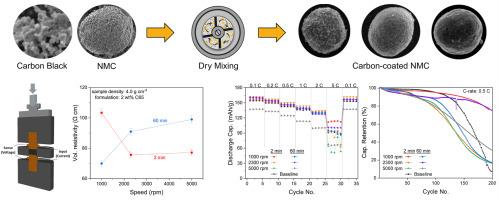Probing carbon black deagglomeration in lithium-ion battery cathode manufacturing using powder resistivity metrics
IF 7.9
2区 工程技术
Q1 CHEMISTRY, PHYSICAL
引用次数: 0
Abstract
Carbon black dispersion is critical to achieving a percolated network in lithium-ion battery electrodes. Existing knowledge relies on legacy insights, lacks mechanistic understanding, and direct quantification of dispersion remains challenging due to nanoscale particle sizes. This study presents the first mechanistic investigation of carbon black deagglomeration via mechanofusion, using powder resistivity to examine deagglomeration behaviour, linking dry mixing parameters, CBD structures and coating characteristics. Low powder resistivity can be achieved with a short mixing time, while optimal mixing speed depends on carbon loading and mixing time. Inadequate mixing results in inhomogeneous distribution of conductive additives, and excessive mixing breaks down large carbon black structures necessary for long-range conduction, increasing powder resistivity. While powder resistivity correlates with deagglomeration, it does not directly predict electrochemical performance. These findings highlight the importance of a combination of long and short-range contacts in the carbon binder domain, facilitated by conductive carbon coatings, to enhance electrochemical performance. This work introduces a practical technique to assess carbon black deagglomeration, traditionally evaluated through slurry, electrode, or cell-level properties. Powder resistivity can be effectively used to correlate carbon black structures with dispersion during mixing, providing a valuable tool for data-driven optimisation of mixing processes and conductive network formation.

用粉末电阻率法探测锂离子电池正极制造中炭黑的脱团
炭黑的分散是实现锂离子电池电极渗透网络的关键。现有的知识依赖于传统的见解,缺乏机制的理解,并且由于纳米级颗粒的大小,直接量化分散仍然具有挑战性。本研究首次提出了通过机械熔合对炭黑脱团聚进行机理研究,使用粉末电阻率来检查脱团聚行为,将干混合参数、CBD结构和涂层特性联系起来。较短的混合时间可以实现低的粉末电阻率,而最佳的混合速度取决于碳的装载量和混合时间。混合不充分导致导电添加剂分布不均匀,过度混合会破坏远距离导电所必需的大炭黑结构,增加粉末电阻率。虽然粉末电阻率与脱团聚有关,但它不能直接预测电化学性能。这些发现强调了在导电碳涂层的促进下,碳结合剂域的长距离和短距离接触组合对提高电化学性能的重要性。这项工作介绍了一种实用的技术来评估炭黑脱团聚,传统上通过浆料,电极或细胞水平的性质进行评估。粉末电阻率可以有效地用于将炭黑结构与混合过程中的分散相关联,为数据驱动的混合过程优化和导电网络形成提供了有价值的工具。
本文章由计算机程序翻译,如有差异,请以英文原文为准。
求助全文
约1分钟内获得全文
求助全文
来源期刊

Journal of Power Sources
工程技术-电化学
CiteScore
16.40
自引率
6.50%
发文量
1249
审稿时长
36 days
期刊介绍:
The Journal of Power Sources is a publication catering to researchers and technologists interested in various aspects of the science, technology, and applications of electrochemical power sources. It covers original research and reviews on primary and secondary batteries, fuel cells, supercapacitors, and photo-electrochemical cells.
Topics considered include the research, development and applications of nanomaterials and novel componentry for these devices. Examples of applications of these electrochemical power sources include:
• Portable electronics
• Electric and Hybrid Electric Vehicles
• Uninterruptible Power Supply (UPS) systems
• Storage of renewable energy
• Satellites and deep space probes
• Boats and ships, drones and aircrafts
• Wearable energy storage systems
 求助内容:
求助内容: 应助结果提醒方式:
应助结果提醒方式:


